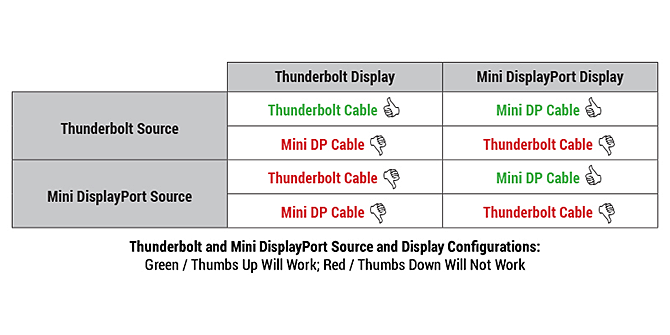Mini DisplayPort vs Thunderbolt: What’s the Difference?
October 23, 2023 | 3 minute read time
Thunderbolt™ 1 or 2 and Mini DisplayPort may use the same connector, but that doesn’t mean they can always function together.
Mark Jagielnik
Mini DisplayPort is a passive technology with its sole function to deliver audio/video signals from a source to a display. DisplayPort 1.2 technology is known for outstanding performance capabilities with support for uncompressed full-color 4K video at 60 Hz, multi-channel audio and 3D stereo. But that’s the limit of its awesomeness.
Not so fast…just because Thunderbolt™ 1 or 2 and Mini DisplayPort use the same connector, that doesn’t mean you can always plug one into the other and get results.
Mini DisplayPort is a passive technology with its sole function to deliver audio/video signals from a source to a display. DisplayPort 1.2 technology is known for outstanding performance capabilities with support for uncompressed full-color 4K video at 60 Hz, multi-channel audio and 3D stereo. But that’s the limit of its awesomeness.

Thunderbolt is a specialized type of Mini DisplayPort connectivity. Although the shape and size of the connector is the same, it does more and does it faster. Thunderbolt can carry data, so it can be used to connect devices such as docking stations and hard drive enclosures. It was developed to support fast data transfer and high bandwidth on a single cable to bring desktop-like speeds to mobile devices. Thunderbolt can also deliver up to 10W of power-over-cable.
Will Thunderbolt Work With Mini DisplayPort?
Mini DisplayPort devices will work with a Thunderbolt-enabled computer, but Thunderbolt devices will not work with a Mini DisplayPort computer. And while a Thunderbolt-enabled computer can connect to a Mini DisplayPort monitor, the technology of the cable needs to match the technology of the display.

Something to note: the information here applies only to Thunderbolt 1 and 2. The new Thunderbolt 3 technology uses a USB-C connector, with even faster speeds and up to 100W of power-over-cable. It is backward compatible with Thunderbolt 1 and 2 devices using an adapter.
Previous Blog Posts by Category
Mark Jagielnik
Eaton Product Manager – Work From Anywhere & Power Cords, Cables & Connectivity | Mark is a creative product manager always looking for new ways to enhance customer experiences in their workplace, wherever their workplace is. He’s responsible for growing a category of products that include docking stations, hubs and multiport adapters, device charging products, power cords and more.






